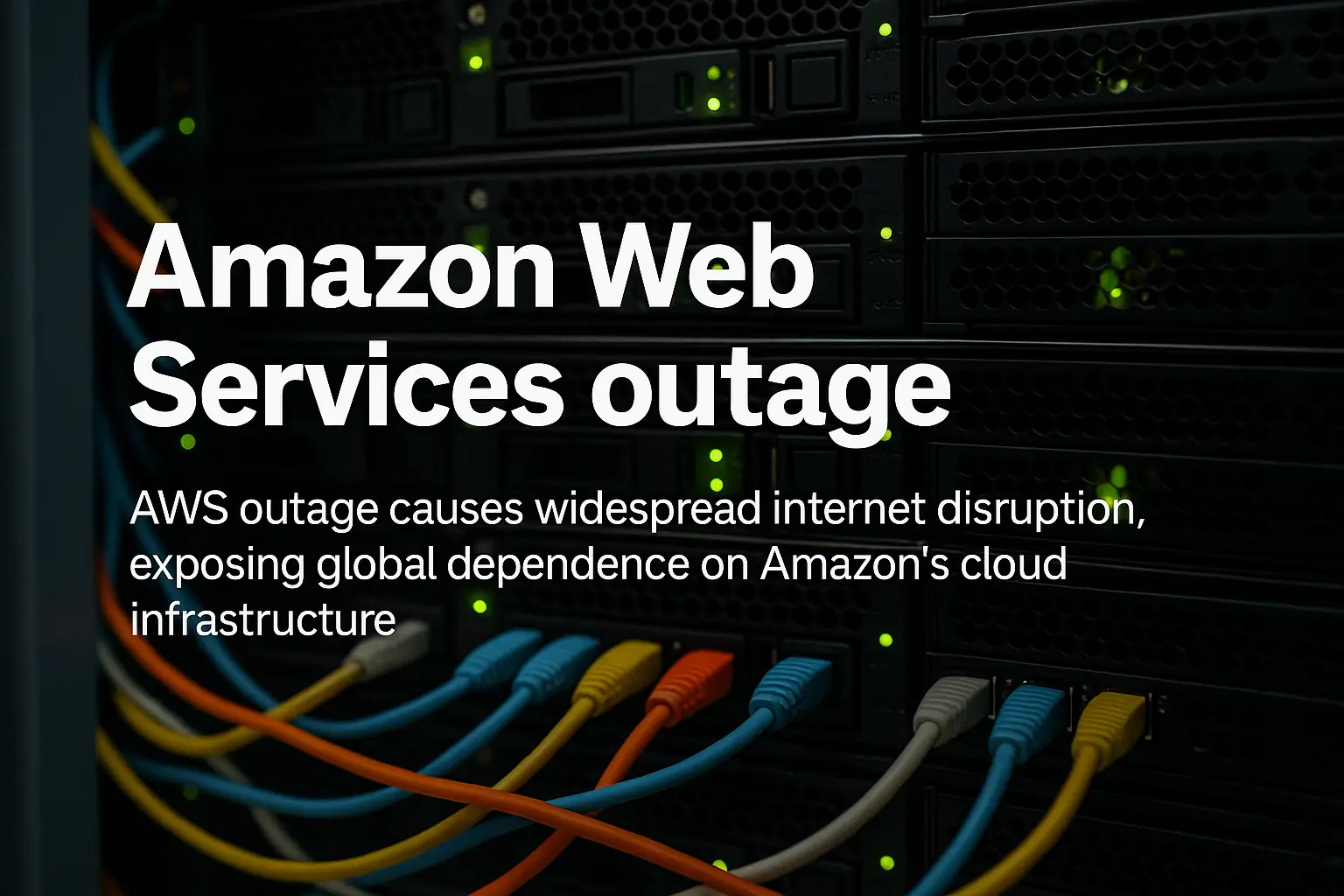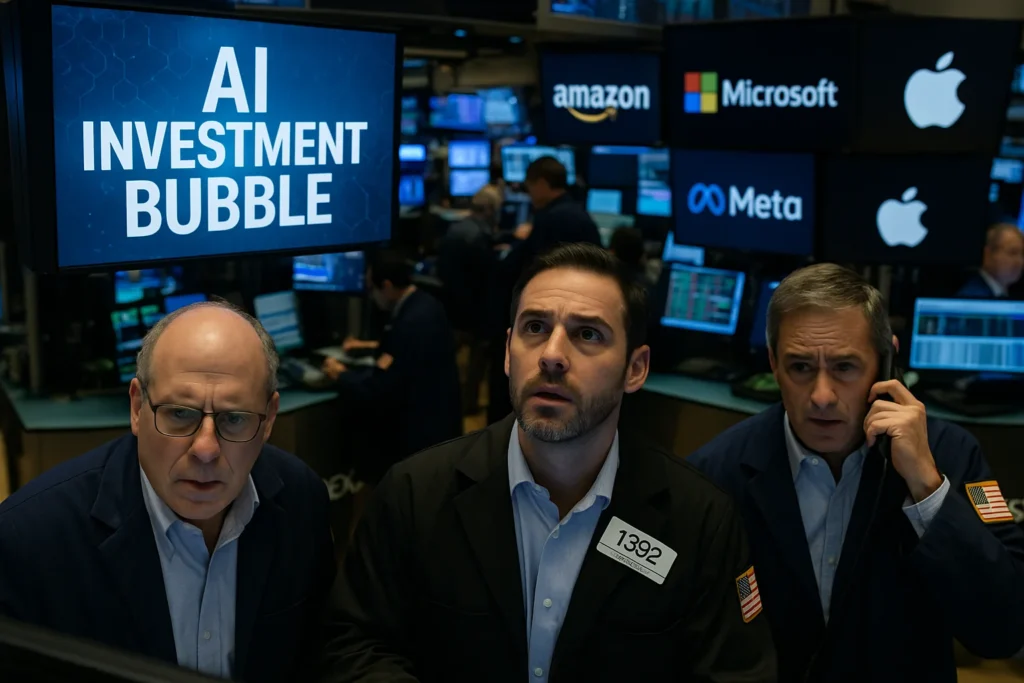It happened again — and the world stopped. When Amazon Web Services (AWS) went dark this week, millions of users across continents suddenly found themselves staring at frozen screens. Streaming platforms, online stores, delivery apps, even government portals — all unresponsive. Within minutes, the outage spread across the digital ecosystem like a shockwave, exposing a truth that few in Silicon Valley care to admit: the internet is not decentralized. It’s hanging by a few corporate threads, and one of them just snapped.
Context: when one cloud collapses, the world follows
AWS, the cloud-computing arm of Amazon, powers roughly 32% of the world’s cloud infrastructure. Behind the scenes, it supports everything from Netflix and Zoom to national weather systems and hospital data centers. For most users, the “cloud” sounds like something abstract — an invisible digital sky. But when that sky collapses, it becomes terrifyingly real.
On October 21, 2025, just after 9 a.m. ET, AWS began experiencing widespread disruptions. Users from North America to Asia reported outages in core services — EC2 (virtual servers), S3 (data storage), and Route 53 (domain routing). By noon, the cascading failure had crippled online payments, news sites, logistics systems, and public infrastructure apps.
Amazon acknowledged the problem but initially offered no cause. “We are investigating increased error rates,” read the dry update on the AWS status dashboard — an understatement for a digital catastrophe. Within hours, the phrase “AWS outage” dominated headlines and hashtags.
Oppositional Argument: the myth of infinite reliability
The tech industry has long sold the cloud as a miracle of resilience — distributed, redundant, fail-safe. But the Amazon Web Services outage shattered that illusion. If a single data region in Virginia or Frankfurt can bring down a tenth of the global internet, what exactly are we decentralizing?
Behind every sleek startup and billion-dollar unicorn lies a quiet monopoly: a dependence on AWS, Microsoft Azure, or Google Cloud. They promise “uptime” and redundancy, but in truth, they’ve centralized risk on an unprecedented scale.
When a regional AWS hub fails, it’s not just Amazon that suffers. It’s your grocery delivery, your ride-share app, your health insurer, your national railway booking system. The supposed cloud “independence” is an industrial delusion — one outage away from global paralysis.
For years, cybersecurity analysts have warned that the concentration of digital infrastructure into a handful of corporate silos creates a systemic vulnerability. Yet governments and corporations alike keep buying into the myth: outsource everything, trust the cloud, save on IT costs. The result? An economy that can grind to a halt because a single configuration bug in Seattle or Dublin cascades through the world.
Analytical Breakdown: how AWS became the world’s nervous system
Founded in 2006 as an internal experiment, AWS quickly transformed into Amazon’s most profitable division. In 2025, it generated over $100 billion in annual revenue — more than many countries’ GDPs. Its clients include Netflix, NASA, Pfizer, and the CIA.
AWS operates more than 100 availability zones across 30 geographic regions. In theory, each region is independent. In practice, they are deeply intertwined through internal routing protocols and authentication systems.
When one zone suffers a glitch — whether from hardware failure, network congestion, or software misconfiguration — it can trigger ripple effects across dependent services. That’s what happened during the 2021 AWS outage, when a routine network update crashed internal tools used to coordinate fixes. This week’s event appears similar: a failure in a key identity management or routing service that crippled access to otherwise healthy servers.
The architecture’s strength — its interconnectedness — becomes its weakness. As one Amazon engineer admitted anonymously on Hacker News: “AWS is like a brain with shared nerves. When one nerve misfires, the body seizes.”
Human Perspective: a digital blackout in real life
At first, it seemed like a glitch. Then chaos followed. Food delivery couriers couldn’t access their apps. Patients missed telemedicine appointments. Streaming platforms went offline. Even some government emergency systems were briefly unreachable.
For millions working remotely, productivity collapsed. “It felt like someone unplugged the world,” said an IT consultant in Berlin. “We’ve built everything — communication, commerce, entertainment — on a single infrastructure, and we just watched it fail.”
Small businesses were hit hardest. Many rely entirely on AWS-based e-commerce platforms or SaaS systems. One retailer in Toronto described losing “an entire day of revenue before lunchtime.” Others faced data synchronization issues, broken payment systems, and frustrated customers.
Counterarguments
Amazon defenders argue that no infrastructure is immune to failure and that AWS still maintains higher uptime than most competitors. That’s true — technically. But critics point out that the scale of dependency changes the equation. When AWS goes down, it’s not “a company issue,” it’s a civilization issue.
Cloud providers love to market “redundancy,” yet their business model discourages true diversification. Migrating to multiple clouds is complex and expensive. Even governments that talk about resilience rarely practice it.
In truth, most organizations prioritize convenience and cost over safety. They centralize because it’s easy — and AWS knows it.
The deeper failure: monopoly disguised as innovation
Every AWS outage exposes the same contradiction: Big Tech’s promise of progress hides a monopoly built on fragility. The “cloud revolution” didn’t decentralize computing — it privatized it.
Three companies — Amazon, Microsoft, and Google — now control nearly 70% of all global cloud infrastructure. Their systems are proprietary, opaque, and increasingly essential to critical infrastructure. Banks, hospitals, defense systems — all depend on private data centers governed by corporate service agreements rather than public accountability.
The AWS incident is not just a technical glitch. It’s a reminder that we’ve handed the digital arteries of modern civilization to profit-driven corporations.
Imagine if all global electricity were controlled by three private utilities — and one failed. That’s the internet in 2025.
Insider View: panic inside the machine
According to leaked internal communications obtained by TechCrunch, AWS engineers worked overnight to trace a recursive loop in an internal authentication module affecting EC2 instances. The bug reportedly propagated through a routine patch that failed validation but went live due to an automated update trigger.
By 3 a.m. GMT, internal Slack channels were flooded with “all-hands” alerts. One engineer reportedly wrote: “We’re flying blind — can’t even access our monitoring dashboards.” The irony: the outage broke the very tools needed to fix it.
While Amazon’s official statement maintained calm professionalism, internal chatter revealed urgency bordering on panic. “The system is too complex to fail gracefully,” admitted one senior developer. “Every fix risks breaking something else.”
That confession speaks volumes about modern tech infrastructure — systems so intricate that even their creators fear touching them.
Global Fallout: from TikTok to Tesla
By mid-afternoon, the outage’s reach had become global. Netflix streaming froze in Europe. TikTok login servers in Asia-Pacific failed intermittently. Tesla’s vehicle app connectivity was briefly interrupted. Even major news outlets, including CNN and Reuters, reported publishing delays.
Airlines using AWS-based booking systems scrambled to restore check-in services. Logistics companies like FedEx and DHL faced tracking blackouts. Cloud-dependent AI tools, including OpenAI’s own APIs, experienced degraded performance.
In short, the world discovered just how much of its “independent” technology quietly runs on Amazon.
Lessons unlearned: déjà vu from past outages
This wasn’t the first wake-up call. In 2020, AWS’s Kinesis Data Stream failure crippled Ring doorbells, Roomba vacuums, and multiple smart-home systems. In 2021, a misconfigured network device triggered massive downtime for Amazon.com itself. Each time, the company promised better safeguards — and each time, it happened again.
Experts say the problem isn’t technical but structural. “AWS is too big to be reliable,” says Guillaume Laurent, a former engineer at a European cloud firm. “They’ve built something no one fully understands. The more they automate, the more unpredictable it becomes.”
Regulation vacuum: governments still asleep
Despite multiple outages and data breaches across Big Tech, regulation of cloud infrastructure remains minimal. The EU’s Digital Markets Act and upcoming U.S. Cloud Oversight Bill address antitrust behavior but not systemic resilience.
Cybersecurity officials in Brussels now warn that cloud centralization is a national security issue. A confidential European Commission report leaked last year stated: “A single point of failure in a dominant cloud provider could disable critical sectors across the Union.”
And yet, procurement policies keep rewarding the same giants. Even NATO uses AWS for certain logistics and communications systems — a strategic dependency that seems almost reckless.
The illusion of innovation: Big Tech’s accountability void
Amazon’s post-outage statement thanked customers for their “patience” and promised a “full root-cause analysis.” But don’t hold your breath. The last three major AWS incidents produced vague explanations, carefully stripped of internal responsibility.
That’s the deeper issue: accountability. In the analog world, power utilities and telecom networks are public or heavily regulated. In the cloud world, they are private, unaccountable, and profit-driven.
We don’t just depend on AWS — we’re owned by it.
Human cost: digital dependence and the emotional toll
Beyond economics and politics, there’s a psychological dimension. Humanity’s growing dependence on cloud systems means each outage feels existential. The panic, frustration, and helplessness people experience during these events mirror our collective fear of losing control.
We’ve entrusted our communications, our memories, our businesses — even our identities — to invisible machines. When they fail, we’re reminded how powerless we’ve become in the digital age.
Conclusion: time to decentralize or prepare for collapse
The Amazon Web Services outage of October 2025 is not an isolated malfunction. It’s a symptom of a deeper disease — global digital over-centralization. Every new startup built on AWS, every government system migrated to Amazon’s servers, every public service that depends on “the cloud” makes humanity more vulnerable to a single point of failure.
The internet was meant to be a web — redundant, distributed, democratic. Instead, we’ve built a corporate pyramid where one error can silence the world.
If this doesn’t push governments, enterprises, and users to demand true decentralization, the next outage won’t just break websites — it will break societies.
External Links
70 views






